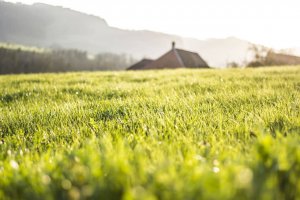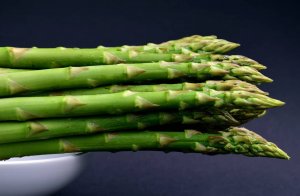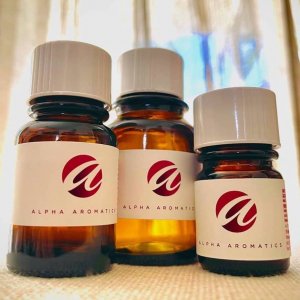Fragrances and colors greatly influence human emotional states and behaviors.
Green is highly pervasive in the natural world, second only to blue as a favorite, albeit it falls into both realms of existence; namely color and scent, which no other color can properly claim.
Green is calming, soothing, symbolic of peace, ecology, eternal renewal and spring.
Green notes in perfumery concern the distinct and unmistakable scents of crumpled leaves, cut stems, foliage, green tea, mosses, green vegetal scents or newly mown and fresh grass lovingly dotted with morning dew.

Included in this unique fragrance category are also what are known as fougère fragrances, or “fern like”.
Green notes evoke memories and olfactory sensations more potently that any others and they are most commonly used in sporty fragrances and summertime versions of popular perfumes.
Usually placed within the top or middle notes of a formulation, green notes provide an initial stream of freshness, elegance and timelessness to a scent.
Perfumes become pure, lively and fresh, laden with both softness and more than a dash of élan. Inspired by nature’s diversity, these notes can be aromatic, herbaceous or powdery.
In Western culture, green is closely linked to nature, new beginnings, Spring, health, youth and the color of permission and environmental concerns.
Sayings and expressions cement these associations such as :’green thumb’ ‘green light’ or ‘greener pastures.’
Lighter greens are more reflective of youth, fresh grass and spring, while darker foliage or forest greens are integral to the harmony and balance of nature.

In China, jade is a precious symbol, of youth, trust and beauty; the Japanese regard it as the color of eternal life.
In ancient Persia, greens mixed with blue represent paradise.
A Short History of Green Fragrances
Deriving from the old English word, grene, the word, green, shares the same linguistic roots as grass and grow.
The color of green ranges from bright, neon with whispers of yellow to the sparkling, deeper and lustrous shades of emeralds and even deeper and darker greens of jungle foliage and vegetation.
Perfumes often mirror the times in which they appear, and the first use of green notes in fragrance dates back to turbulent days following the Second World War. and a tired populace seeking renewal and hope.
Fashion designer, Pierre Balmain, hired chemist and French female perfumer, Germaine Cellier, to create Vent Vert, which appeared in 1947.
This floral green fragrance marks a real turning point in the world of perfumery with its stunning, plentiful facets of essence of galbanum and basil, which rendered an intensely green character.
This creation was considered avant-garde for the time, but it paved the way for other compositions using green and chypre accords, which are built around a woody, mossy amalgam.
Green notes fell out of favor for a few years, as they could not compete with the advent of gourmand fragrances.
They did, however, return in full force in 2010, as the need for change, environmental concerns and return to neutral basics took hold of the industry.
It’s important to note that perfumers have since altered the original character of green notes to reflect consumer demand, and they became softer and more inclusive of fruity and floral nuances.
The Specific Categories of Green Notes Used In Perfumery
Part of the life’s work of a master perfumer consists of using green notes in the most effective fashion, which is usually within the top or heart notes of a formulation.
Below are the major categories from which they work.
Freshly Cut Grass Fragrance
A freshly cut lawn is perhaps the greenest scent of them all.
It is uplifting and totally captivating without the addition of any other elements.

The aroma derives from a chemical reaction, and is an airborne amalgam of carbon-based compounds known as green leaf volatiles (GLVs).
Grass releases these specific molecules when it is damaged by insects, infections or the force of a lawn mower.
Vegetal Green Fragrances
Fresh green vegetables such as: bell peppers, green peas and asparagus, all have their own distinctive and characteristic smell.

This is due to the nitrogen-bearing compounds known as pyrazines, which are naturally occurring substances with low odor thresholds that are renowned for their extremely potent aromas.
Despite its apparent simplicity, the vegetal note is difficult to handle. In too small a quantity, its volatile notes will quickly fade away in favor of other more powerful ingredients.
Too concentrated, they will become bitter and squeaky.
Floral Green
Some formulations blend basic green characteristics with floral facets, particularly a a note called galbanum, which is a fragrant gum resin that adds freshness and depth.
Sharper and brighter than traditional florals, these green fragrances combine a floral bouquet with green notes, which renders vitality and freshness.
These aspects also balance very well with aromatic woody notes.

Natural Green Notes
Transforming nature into a perfume bottle involves skill and precision the likes of which can be appreciated in the many formulations we create.
Developing natural green notes involves incising the roots of the galbanum plant in order to obtain a resin which is then distilled and captures the potent essence of this very fragrant shrub, which manifests itself in the form of an earthy green note.
Native to Afghanistan and also known as “gummy ferule,” some say the aroma of galbanum is similar to fresh, damp peas.
Other natural green notes include: the blackcurrant bud, which is a very costly raw material with a sour and sulphur smell; the violet leaf, which emits a green, powdery and earthy scent, and the rare mastic tree from the Mediterranean region of the world.
Petitgrain Essential Oil
The name Petigrain derives from “little grains” as it originally came from green, unripe oranges that were barely the size elf cherries.
Today, this substance comes mostly from the leaves of the lemon tree.
Today, most petitgrain production occurs in France, Italy and Paraguay, with some in North Africa. Its scent is greatly affected by the terrain, soil and climate within which it is grown.
Alpha Aromatics And Our Use Of Green Fragrances
Much like the birth of green fragrances, our routes similarly stretch back to the moments just after World War II.
It was at that time that our ancestors began a long and arduous climb to world success and leadership within the perfume industry.

Our focus has remained unchanged since our inception; and that is specific to “build great scents that build great brands.”
Located in suburban Pittsburgh, Pennsylvania, our brand of olfactory magic concerns the masterful ability to transform the vision of any enterprise into an unforgettable communion between products and consumers that is certain to attract and inspire traffic and induce brand loyalty.
Dynamic, cheerful and natural, the green facet, is frequently used in the fragrances we develop for a vast array of business sectors, which include but are not limited to personal care products, candles and diffusers, fragrances for home, odor neutralizers, private label brands, industrial air fresheners, household cleaning products and fine, customized perfumes.

The secret to our enduring success is no mystery at all — we showcase modern brands and help to build consumer loyalty both with the creation of our vast array of superior fragrance formulations and our compelling business strategy, which is unilaterally focused on meeting the dynamic needs of the global marketplace.
The following represent a partial list of some of our most memorable, recently designed green fragrances.
Cyclamen And Moss
Flowing facets of sweet, floral and woody wild berries and fresh, clean citrus rind form the top notes of this green formulation.
These aspects quickly fade into a heart note bouquet featuring dreamy, musky rose, fragile, soft and green lily-of-the-valley, light, musty and floral cyclamen and light, bitter neroli.
A base note of earthy, bright fresh cut grass, soft, pungent leather, green, moist moss and earthy, nutty dry sage complete this fragrance.
Fig Leaf And Thyme
Top notes of tangy and woody nuanced facets of raspberry leaf and bittersweet, intimate saffron open this glorious, green fragrance.
These aspects soon fade into a heart note characterized by potent, hot thyme, earthy and nutty sage, intoxicating jasmine and green, fresh and sticky fig leaf.
Elements of musty, cool and spicy frankincense, dark, rich and honeyed amber and soft, powdery and sensuous suede complete this memorable scent.
Green Leaf And Vetiver
Top notes of fruity, sugary casaba melon, crisp apple and fresh, light and cool green leaves open this intensely refreshing fragrance.
These facets quickly drift into a floral heart note featuring romantic and musky rose, intoxicating jasmine and clean, slightly sweet sea kelp.
The scent finishes with a base note formed by aspects of green, musty, balsamic vetiver, earthy musk, sensual, bright and vanilla-nuanced sweet grass and muddy, earthy and smooth clay.
Sweet Grass And Clay
This refreshing green fragrance streams with top notes of fresh, sharp lime zest, soft, floral and fruity-nuanced peach blossom and green, sappy aloe leaf.
These aspects soon drift into a redolent floral heart note marked by facets of dreamy, musky rose, haunting desert jasmine and earthy, bright sweet grass.
The scent completes with a base note featuring elements of warm, dark amber, intense, woody and balsamic galbanum and aromatic, sensual white musk.
Violet Leaf And Fern
This unforgettable fragrance opens with a citrus rush of sharp, clean lemon, elegant, bitter and complex bergamot and fruity, slightly sweet and dense pear.
These elements soon drift into a floral heart note featuring facets of metallic, aqueous violet leaf, musky, velvety and romantic rose, woody, herbal geranium and powdery, vanilla-nuanced heliotrope.
Aspects of creamy sandalwood, sensual, passionate musk and damp, sensual and woody fern complete this superior fragrance.
In Conclusion
If you’d like to weave the earthy fragrant notes of herbs, ferns, snapped leaves or freshly-cut grasses into your product or product line, contact our teams today and discover what world of “green” can do for your company and that all-important bottom line.
Photo Credits: Pixabay
 alpha aromatics®
alpha aromatics®